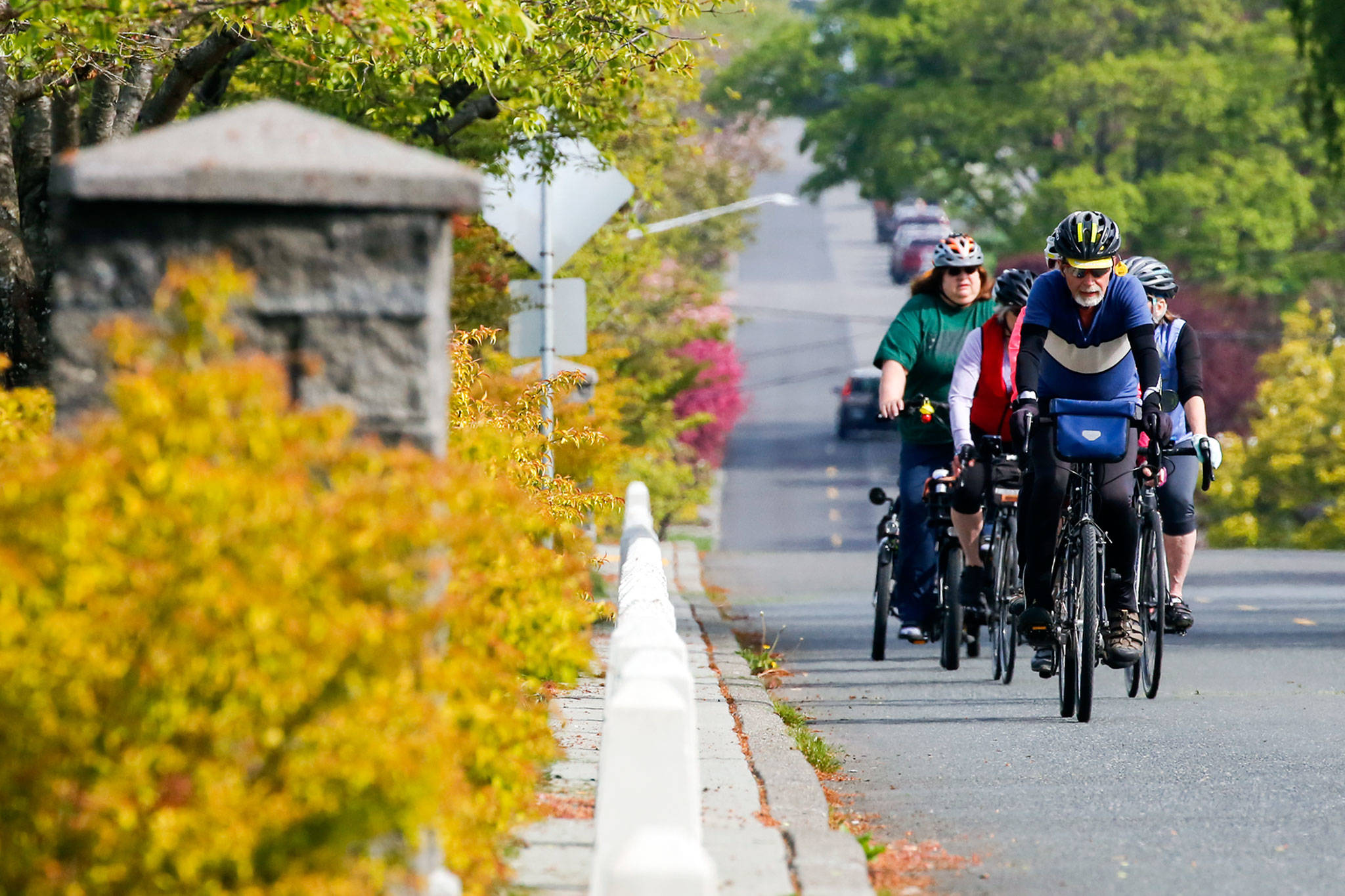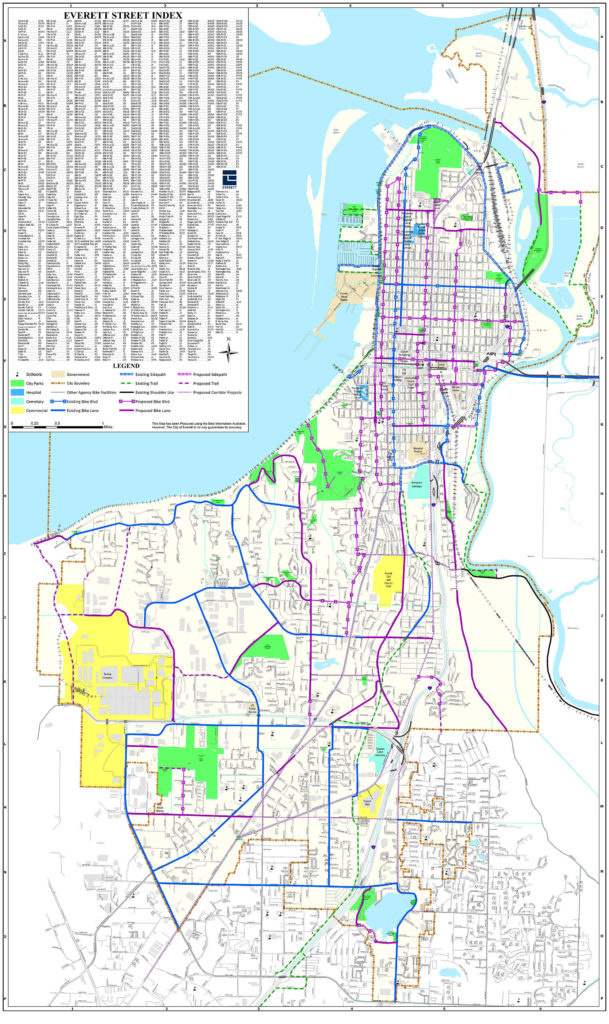The air is warmer, the days are longer, and the lanes, roads and trails are calling.
It’s national bike month, as declared by cycling groups including The League for American Bicyclists, a national organization founded in 1880. More locally May’s 31 days are taking shape as Bike to Work Month at the Washington State Department of Transportation, Bike Everywhere Month by the Cascade Bicycle Club, as well as Bike Bingo through Sharing Wheels Community Bike Shop in Everett and a monthlong “bike everywhere” challenge hosted by the BIKES Club of Snohomish County.
This month, Street Smarts will focus on different areas of cycling news in Snohomish County, including infrastructure plans in Everett and Edmonds, how people here use e-bikes and potential legislation to lower their costs, revisiting how bike shops have fared through the pandemic, and an update about my commitment to biking, busing and walking instead of driving everywhere.
It feels like another life when we could rent a Lime electric scooter for a battery-powered roll around Everett. But the program was suspended last year and city leaders don’t plan to resume it while the COVID-19 pandemic rages, even as other cities restart or launch similar programs.
Then Everett restricted a few road sections to local access during its Healthy Street Initiative last summer and fall to make more room for outdoor exercise during a time when other forms of exercise were limited. But that program won’t resume either.
Instead, city staff are focusing on implementing the Bicycle Master Plan, an element of its comprehensive plan and transportation improvement plan.
Everett, the county’s most populous city, has had the document for a decade. With priority tiers for projects and an inventory of cycling infrastructure, it’s a useful reference for the city that has almost 53 miles of bike lanes, 13 miles of bike trails, over eight miles of sidepaths used by bike riders and pedestrians, and just under eight miles of bike boulevards shared between cyclists and drivers, plus another several dozen bike racks and repair stations.
Bill Weber, 64, is an ardent bike rider who has lived in Everett for over 30 years. He helped craft parts of Everett’s Bicycle Master Plan and has put the city’s roads to the test with about 20,000 miles — plenty of which came from multiday rides elsewhere — on his custom touring bicycle.
Since the plan was implemented, the city added 24 miles of bike facilities, which include marked roads shared with vehicles, striped bike lanes, and paths or trails physically separated from vehicle traffic. Those miles account for bike lanes on Hoyt Avenue installed during the Rucker Renewal Project and the upcoming addition of five-foot wide bike lanes on the Edgewater Bridge replacement on Mukilteo Boulevard.
“For me, it’s obviously necessary, it’s an important element of how we get about as people,” said Everett transportation engineer Christina Anna Curtis.
The plan was updated in 2017 with several projects including the California Street bike crossing at Broadway and the now completed Grand Avenue Park bridge to West Marine View Drive.
Recently, the city finished connecting a bike trail from Pacific Avenue to the Interurban Trail, and from Hoyt and Pacific avenues with the Interurban Trail at 44th Street SE.
Everett staff and cycling advocates said these investments are important for letting more people travel without a car, a critical goal for reducing emissions that contribute to climate change and easing the traffic crunch in an area experiencing high population growth.
“It’s really better for everyone because if you provide an alternate mode of transportation, someone who has a car doesn’t have that extra car behind him,” Curtis said. “It provides an active way for people to get where they’re going.”
This year, the city is adding “sharrows” designating a road as shared for cyclists and drivers to about 1.3 miles on four different stretches of road. Everett planners also are designing six miles of new bike and pedestrian facilities. The projects are: $900,000 for bike lanes on both sides of 100th Street SW between Everett city limits at 24th Place W and Evergreen Way; $1.17 million for a bike and pedestrian corridor on California Street east of Broadway to Hewitt Avenue where a path alongside the U.S. 2 trestle takes people to Ebey Island and toward Snohomish; and $500,000 for a corridor on Fleming Street which parallels Evergreen Way between Madison Street and 35th Street.
The plans were welcome news to Weber and fellow longtime cyclist Dan Scott.
“Fleming is a good one to parallel Evergreen Way,” Weber said, noting the connection to Forest Park, Jackson Elementary School and other areas in the South Forest Park and Port Gardner neighborhoods. ”I’d really like to see a bit more of the connections reviewed.”
Scott, 71, used to bike to work when he was a teacher. Now he’s retired but still hops on his road bike, touring bike, or a tandem with his wife. Over his 47 years in Everett, most of which he has lived in the Cascade View neighborhood, he has seen the improvements made to biking through the city.
But some nagging challenges have lingered, including crossing busy roads.
“A big problem is getting across 41st (Street),” Scott said.
Last year the city connected the bike lanes of Hoyt Avenue to the intersection of 41st Street and Colby Avenue, which leads to the Interurban Trail. But active transportation advocate Tyler Rourke, who lives in Everett and is chairman of the city’s Transportation Advisory Committee, had proposed a bike signal on Hoyt Avenue to cross 41st Street similar to what the city installed at California Street and Broadway.
Weber said he wants the city to improve east-west cycling links such as 23rd Street. The road meets the Mill Town Trail at its eastern end and Grand Avenue to the west. The street is adjacent to two schools, three parks, and within a block of two more schools.
“It’s a perfect corridor for bike to schools, bike to parks, in a neighborhood,” he said. “I’ve been presenting this to everybody in the city that will listen.”
Those kinds of connections in the north end could be important for growth around Everett Community College and Washington State University Everett campuses.
Plans to complete the connection between downtown Everett and the U.S. 2 trestle path to Ebey Island and Snohomish were welcome news to Scott. To stay off Hewitt, riders can follow California Street to Maple Street, then turn east toward the trestle path which runs along the south side of the highway across the Snohomish River.
But Scott said people biking into Everett who don’t know how busy Hewitt Avenue is could be confused about where they should ride.
“As you come into Everett, you wonder, ‘Now what do I do?’” he said.
Of course the problem is money. Replacing the Edgewater Creek Bridge, a $22 million project in total, is one of the most expensive transportation capital expenses Everett has slated this year, as well as over $2.8 million for overlay work and $2.4 million for an interchange justification report study for I-5 and U.S. 2. In all of that work, Curtis evaluates potential for bike and pedestrian facilities or improvements.
“We actively look for funding in bicycle projects,” Everett principal engineer Tom Hood said.
Beyond the missing connections between existing bike lanes and trails, sometimes what’s in place doesn’t work right. Problems such as traffic signal sensors in the road not detecting a bicycle, especially ones made of carbon fiber, can be resolved by contacting the city’s public works department or submitting an online service request. But riders should make sure they’re on the right spot that should be marked with a bike detection symbol on the road because the sensor loop in the road is calibrated for bikes.
Hit the road
Everett has a few prime protected bike trails worth riding.
Interurban Trail generally parallels I-5 and leads riders into Seattle, if they wish.
Lowell Riverfront Trail follows the Snohomish River from Rotary Park to 41st Street or into the new Riverfront development; and Mill Town Trail is a north end crescent from East Grand Avenue to West Marine View Drive along the city’s waterfront.
Have a question? Call 425-339-3037 or email streetsmarts@heraldnet.com. Please include your first and last name and city of residence.
Talk to us
> Give us your news tips.
> Send us a letter to the editor.
> More Herald contact information.



























